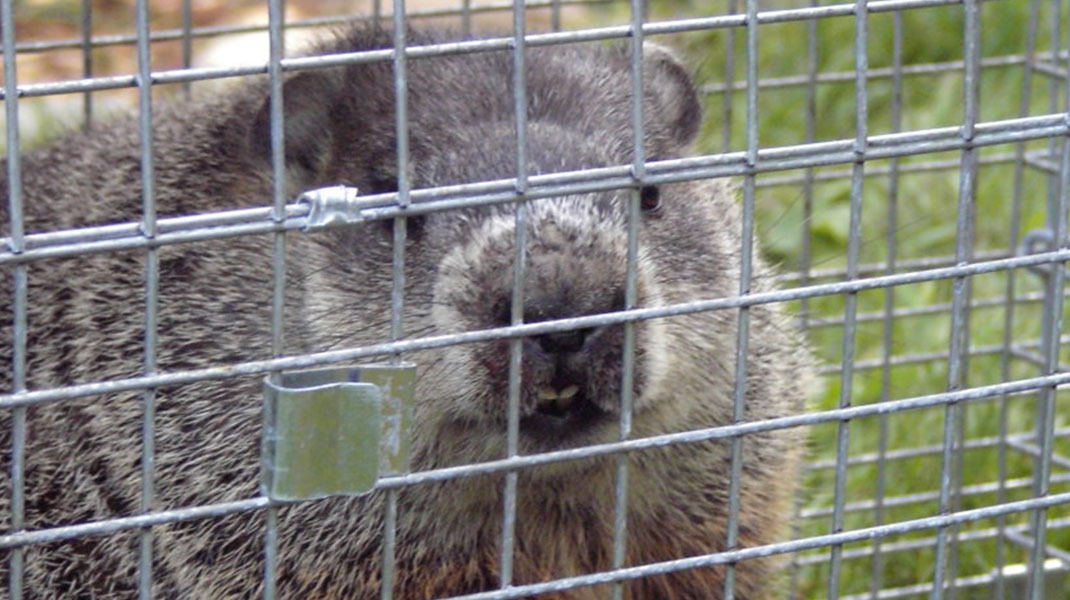Groundhogs

Biology
One of the largest rodents to be found in the United States, the groundhog, also known as the woodchuck, has a sturdy thick body that is covered in a reddish brown fur, with a large head and dark eyes. The males are naturally the larger of the sexes, and groundhogs are usually between sixteen and twenty-six inches in length, weighing between four and fourteen pounds, getting heavier in the fall when they gain weight to sustain them through the winter. Groundhogs breed in the spring with the female giving birth in late April to May, and they can live for up to six years, with most groundhogs living for between two and three years.
The groundhog will spend much of its time underground, although it does need to leave the den to forage for food, and this will usually mean living near woodland, fields and hedgerows. Groundhogs are usually herbivores eating grass, berries, fruits and various other plants, although where there is a shortage of food they may also eat insects such as grubs and grasshoppers. Groundhogs are quite territorial and will look to protect their area from other groundhogs, and they also hibernate through most of the winter, losing around half of their body weight in the process.
Problems Caused By Groundhogs
A significant issue for many people in small towns or villages can come when a groundhog finds their way into a yard or garden, and starts to make their burrow in that space. Because groundhogs will create quite an extensive burrow, this can undermine the surface of the yard or garden where they are active. In a small number of cases, the burrow could go beneath an outbuilding or even the foundation of a home, which could cause serious damage.
Along with their burrowing, groundhogs can also cause issue because of their feeding habits, as they will start to eat all of the plants in the area around the burrow. This can mean much of the grass from the lawn could be lost, along with flowers, vegetables and fruits being grown in the garden. Groundhogs are also likely to gnaw the bark of any trees or sturdy bushes around the garden, which could kill these plants too. Because they are territorial, groundhogs could also show aggression towards any pets that are living with you in your home.
Prevention Methods
If you are worried about groundhogs becoming active in your yard or garden, there are several ways in which you can take steps to avoid this, but a good fence that is embedded into the ground can be one approach. Because groundhogs will dig their burrows quite deep, this won’t always work, but installing a wire mesh fence below the ground will block them from getting in to the garden. This will only work in certain situations, and can require a lot of work in order to embed the fence properly.
There are also changes that you can make to your garden that will make the space less attractive to groundhogs, in terms of the plants and layouts of the garden. Groundhogs will prefer areas that have wood or bark that they can gnaw, so removing trees, bushes with a thick stem and getting rid of any tree stumps in the yard or garden will help. Some gardeners also believe that groundhogs are particularly fond of dandelions and clover, so keeping your lawn free of these may help.
Removing Groundhogs Professionally
Probably the most common methods that a professional will use when dealing with a groundhog infestation is traps, and these can either be lethal traps which will crush the animal, or cage traps, which will then allow the animal to be relocated. In each case, the trap needs to be placed as close as possible to the entrance of the burrow, and with cage traps they need to be disguised with foliage. Some use a woodchuck lure in the trap, which is a sweet and strong floral scent that is said to draw the groundhog into the trap.
Another option that is sometimes used when dealing with groundhogs is to smoke the den with a carbon monoxide canister. This will involve filling in most of the entrances to the den, before placing the canister into the den and sealing the final hole, with the canister then filling up with the tunnels with the carbon monoxide gas to kill the groundhog. Because the groundhog can dig their way out in some situations, this is not always the most efficient option of dealing with the problem.
Related Groundhog Articles
No Results Found
The page you requested could not be found. Try refining your search, or use the navigation above to locate the post.
